|
Home
About This Site
Air Cleaners
Audio
Carburetors
Charging System
Chassis
Cooling System
Decoding
Detailing Center
Diecast Cars
Differential
Documentation
Driveshaft
Engine Bay Detail
Engine Brackets
Engine - External
Engine - Internal
Engine Tags
Exhaust
Exterior
Favorite Links
Fuel System
Gallery 1
Gallery 2
Gallery 3
Gallery 4
Gallery 5
Gallery 6
Gallery 7
Gallery 8
Gallery 9
Gallery 10
Gallery 11
Gallery 12
Gallery 14
Gallery 15
Gallery 16
Gallery - Photos from For Sale Ads
Heater & A/C
Ignition
Interior
Junkyard Cars
Memorabilia
Mustang Monthly Article Index
Oil Cooler
Paint Info
Parts Sources
Performance Data
Photography
Pulleys/Belts
Registry 71 429 Cougar
Registry 71 429 Mustang
Smog/Emissions
Special Topic
Special Topics 2
Starting System
Statistics
Steering
Suspension
Tech Writeup Index
Transmission
T-Shirts
Trunk
Underhood Component Coatings
Videos
Vintage Ads
Under Hood Non Engine Components
Wheels/Tires
Index
| |

The purpose of this page is to help you locate
and decode the various numbers on the 429 Mustang/Cougar. This page includes
decoding and location info on the:
(Note: Click thumbnails to enlarge pictures.)
| Vehicle Identification
Number (VIN) |
| Where to find the VIN
on the Vehicle |
|
There are five places you can find the VIN on the
vehicle;
1) Dash
Complete VIN is on the driver's side of the dashboard, as shown below.
The red circle indicates where the VIN is located on the dashboard.
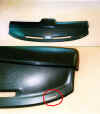

2) Drivers Door
The complete VIN is on a sticker inside the driver's door.


A word about the Driver's Door Decal - Two
different versions of this decal were used in the 71 Model Year. Our
research indicates that the change from Style #1 to Style #2 (see this
thumbnail photo:
 ) occurred in October 1970 between VIN series 1F05J123000 and
1F05J140000.
) occurred in October 1970 between VIN series 1F05J123000 and
1F05J140000.
3) Under Front Fenders
The partial VIN is stamped under each of the two front fenders on top of
the engine compartment sheet metal. Notice it is only part of the
complete VIN. The 1971 model year (1), the assembly plant - Dearborn
(F), and the consecutive unit number (149141). In this case, the 05J is
missing.


4) Engine Block Serial Number
The serial number (aka partial VIN) is stamped on the rear face of the 429 block just below
the driver's side head. The first two and last six digits of the vehicle
VIN (ex: 1F123456) are shown in the photos below. The first digit ("1")
denotes 1971, the second digit ("F") is the Assembly Plant code. The
remaining six digits are the last six of the vehicle VIN. If the vehicle
was a Mustang, this six digit number starts with a "1". If it was a
Cougar, it starts with a "5". Note that this serial number may be
nearly impossible to see when the engine is installed in the car.


More on the Assembly Plant Code
From this
serial number, specifically the second digit (the Assembly Plant code),
you can determine which Vehicle Assembly Plant that the engine was
originally installed into a vehicle in. This is important because
the Vehicle Assembly Plant will tell you the vehicle type the engine
came from and whether the engine originally came from a Mustang/Cougar
or another Ford vehicle. As you can see from our example above,
the second digit is an "F", so based on the table below, this engine
originally came from a Mustang.
A-Atlanta
B-Oakville
D-Dallas
E-Mahwah
F-Dearborn (the only assembly plant that built the
1971 429 CJ/SCJ Mustang and Cougar)
G-Chicago
H-Lorain
J-Los Angeles
K-Kansas City
N-Norfolk
P-Twin Cities
R-San Jose
T-Metuchen
U-Louisville
W-Wayne
Y-Wixom
X-St. Thomas
5) Transmission
The partial VIN is stamped on the transmission. Like the block, the
first two and last six of the VIN (ex:1F123456) are stamped on a flat
pad on the top surface of the C6 transmission or on top of the rough
cast top flange where the trans case meets the bellhousing of the 4
speed top loader. The VIN is usually stamped on the front rail of the
trans case, but may have been located anywhere along the front
rail and not necessarily to the left hand side as seen here.
C6 Automatic


4 Speed Top Loader




Using the complete VIN from your door sticker or
dashboard, you can determine important data about how your vehicle was
originally built. You can
decode your tag by clicking the link to the "Classic Mustang
Decoder"site below:
Classic Mustang Dataplate Decoder
|
|
Engine Decoding
|
|
Engine ID Tag
|
|

The Engine ID tag was a small metal tag placed under
the bolt that held down the ignition coil.

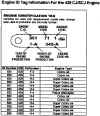
The sample ID tag above left can be decoded as
follows using the chart at above right:
ENGINE CID = 429
MODEL YEAR = 71
CHANGE LEVEL = 8
YEAR OF ENGINE PRODUCTION = 1970
MONTH OF ENGINE PRODUCTION = November
ENGINE CODE NO. = Cobra Jet
(Note: Ford did not use the
letter"I"in date codes because it could be confused with the
numeral"1")
The chart below indicates which engine
code number goes with each vehicle, engine and transmission combination.
|
| 71 429
Mustang/Cougar Engine Tag Application Chart |
|
Engine Tag Code
|
CJ or SCJ |
C6 or 4 speed |
Vehicle Type |
| K833-K |
429 CJ |
C6 |
71 Mustang/Cougar |
| K833-KG |
429 CJ |
C6 |
71 Mustang/Cougar |
| K834-K |
429 CJ |
4 speed |
71 Mustang/Cougar |
| 837-J |
429 SCJ |
C6 |
71 Mustang |
| 838-J |
429SCJ |
4 speed |
71 Mustang |
|
Engine Block Part
Number
|
|




CJ/SCJ Blocks
Correct 429 CJ/SCJ Block Casting Numbers
The red arrow above left indicates the location of
the 429 CJ/SCJ engine block casting number. A closeup is shown at center
of the D0VE-A and the D1VE-6015-AA at right. The 429 CJ/SCJ engines used in
the 71 Mustang/Cougar had either a D0VE-A or a D1VE-6015-AA block.
But here's a special note about the D1VE
block part numbers - CJ/SCJ D1VE blocks have the "D1VE-6015-AA"
casting number while base blocks have only a "D1VE-AA" casting number
without the -6015- in the middle. This appears to be a screw-up by the
factory! D1VE-6015-AA is supposed be a CJ block (since we have
seen more as CJ than non-CJ), but due to the info we have uncovered
(click this thumbnail photo:
 ),
its best to verify first if the block is a thin or thick web before
deciding if it is a CJ. See the two photos below for
examples of this;
),
its best to verify first if the block is a thin or thick web before
deciding if it is a CJ. See the two photos below for
examples of this;


429 CJ/SCJ Main Bearing Webs In addition
to the casting numbers, CJ/SCJ
blocks were signified by having thicker main bearing webs
than the standard 429 blocks. Note
in the photo below how the webs on the CJ/SCJ block (left) get thicker,
stepping from 1” to 1.4” near the intersection of the web to the
sidewall while the base 429 block webs are noticeably narrower;

Also note that the CJ/SCJ webs are taller
and machined to the same height as the oil pan rail.
By contrast, main bearing webs on the base 429 (Thunder Jet)
block at right get thinner as they meet the sidewall and are not as tall
as their CJ/SCJ counterparts. Instead
they are as cast and end below the oil pan rail.
Two -vs- Four Bolt Mains
Since the two or four bolt caps were
added after the block was cast, the casting number WILL NOT tell you if
it is a two or four bolt main block. What it WILL tell you is that the
block has thick main webs, making it a CJ/SCJ block (PI too).
(Thanks to Dan Davis for the above info and
photos)
|
|
Engine Assembly Date
|
|
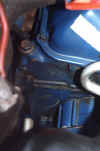

These photos show the location of the engine assembly
date stamping. This is the date when the block was assembled into a
complete engine. For the 429 engine, this code is located just below the
passenger side head, on the front of the block. The code was
sequenced: year-month-day-inspector code. The example shown above
(0F22A) breaks down as 1970 - June 22 - Inspector code A.
|
|
Paper Engine Tag
|
|
 See this link: Paper
Engine Tags
See this link: Paper
Engine Tags
|
|
Engine Heads - CJ Part
Number
|
|



The red arrow shows the location of the D0OE-R part
number on the 429 CJ/SCJ head. The part number is located between the
center two exhaust ports facing upwards. This is the only part number
for 429 CJ/SCJ heads.
|
|
Transmission Decoding
The transmission code to ID
whether you have a 4 speed or C6 is on the sticker on the driver's
door. a "6" is for 4 speed (close ratio) and a
"U" indicates the C6 automatic.
|
|
Transmission ID Tag
|
|


4 Speed Top Loader ID Tag
This is the 4 speed trans ID tag located on the trans
case. The 71 429 Mustang had either a RUG-AZ or RUG-AZ-1 ID code on this
tag.



C6 Transmission ID Tag
The C6 Transmission ID Tag is located under one of
the servo bolts as shown above. Also, note the "R" on the
servo cover. This indicates the transmission has an "R" Servo
which only came on CJ/SCJ Transmissions. The Identification Code for the
429 Mustang/Cougar C6 is PJC-G. At right is an actual tag from a 429
Mustang C6.
|
|
Rear Axle Decoding
|
|
Axle ID Tag
|
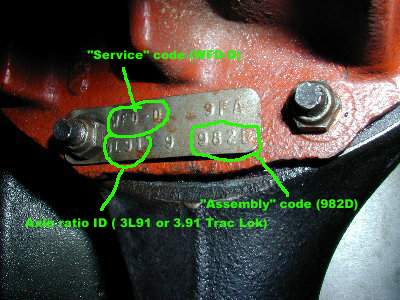
Axle Tags/Codes

The
"assembly code" (e.g., 982D) found on the paper tag on the
axle is the same as is found on the metal axle tag (attached to a
"pig" bolt) and on the build sheet. See picture above
for details.
This
number is not the same as but is related to the "service
code" (see chart below) for the axle (e.g., WFD-D). This is
because the "service" code only identifies the contents of
the pig and axle shaft size. The "assembly code" also
IDs the vehicle application and brake size.
| 429 Mustang/Cougar Axle Service
Code Chart |
|
Service Code
|
Ratio
|
Locking? |
Service Code
|
Ratio
|
Locking? |
Service Code
|
Ratio
|
Locking? |
| WDO-M2 |
3.25 |
Y |
WES-AK |
3.50 |
N |
WFU-E1 |
4.11 |
Y |
| WES-AB2 |
3.25 |
N |
WFB-C2 |
3.25 |
Y |
WFD-F |
3.50 |
Y |
| WES-AD |
3.25 |
N |
WFD-D |
3.91 |
Y |
WFD-FZ |
3.50 |
Y |
| WES-AD2 |
3.25 |
N |
WFD-D2 |
3.91 |
Y |
WES-AE |
3.50 |
N |
| WES-AE2 |
3.50 |
N |
WFD-F2 |
3.50 |
Y |
WES-AK |
3.50 |
N |
| WES-AE3 |
3.50 |
N |
WFD-F3 |
3.50 |
Y |
WFB-C |
3.25 |
Y |
| WES-AJ2 |
3.25 |
N |
WFD-M2 |
3.25 |
Y |
WFD-A |
3.91 |
Y |
| WES-AJ3 |
3.25 |
N |
WFD-M3 |
3.25 |
Y |
WFD-M |
3.25 |
Y |
I
have only seen 3 digits and a letter making up the "assembly
code." However, I could be wrong or ignorant because of a
limited sample size.
(Thanks to Dan Davis for this research and photo)
|
|
Paper Axle Tag
|
|



Paper Axle Tags/Codes
The red arrow on the photo at left indicates the
location of the paper axle tag. This tag is about 1 3/4" wide and
was located
just past the inside U bolt on the axle tube just before it increases in
diameter. The tag is marked with the axle code (ex: "1982A")
multiple times and is wrapped around the axle tube several times.
Below left is an original axle tag removed from a 429 SCJ with a 3.91
axle. At right is another original tag alongside a reproduction.
Group member Johan Lindvall created a template for the 987A at lower
right. If you print it out, size it to be 1 3/4" wide.
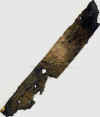


|
|
Decoding the Axle from
the Door Tag
|




1
2
3
4
Above is a selection of Door Tags.
Note that the axle code is key in determining whether or not a car has a
CJ or SCJ engine. The SCJ engine was invoked ONLY when someone ordered a
429 car with a 3.91 or 4.11 rear axle. Tag #1 has an "R" axle
code (3.25:1) and Tag #2 has an "A" code (3.50:1), therefore,
these two cars are CJs. Tag #3 has a "V" axle code (3.91:1)
and Tag #4 has a "Y" axle code (4.11:1). Therefore, these two
cars are SCJs.
| 1971 429
Mustang/Cougar Rear Axle Codes |
| Vehicle/Engine |
Conventional |
Locking |
Ratio |
| 429 CJ Mustang/Cougar |
9 |
R |
3.25:1 |
| 429 CJ Mustang/Cougar |
A |
S |
3.50:1 |
| 429 SCJ Mustang |
N/A |
V |
3.91:1 |
| 429 SCJ Mustang |
N/A |
Y |
4.11:1 |
| * Air Conditioning
only available with 3.25:1 |
|
| Buck Tag |
|

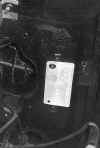

Buck Tags
The buck tag was a metal tag attached to the front
of the radiator support - often on the passenger side. It was used
to ID the partially completed vehicle body at the assembly plant. As
an example, the tag at left decodes as:
1F91J531928 - Vehicle Identification Number
65D - Body Style Code: Cougar Hardtop
21M - Scheduled Build Date: December 21
225 - Assembly Line Sequence Number
backwards 6 - Inspector Number
M - Color: Wimbledon White
1D - Interior Trim: Dark Red Vinyl Bucket Seats
AC - Air Conditioning
PB - Power Disc Brakes (required w/429CJ)
DE - Dual Exhaust
|
Link to a Helpful Website on Decoding Ford
Products:
Gearhead Racing
| How To Identify a 429 SCJ
(Drag Pack) Car |
|
First off, is the fifth digit of the VIN a C or a J
 ? That's your starting point. If anything else, it is not even an original
big block car. Now that we have established that it is a 429 car, check
the door tag. If you are lucky enough to find a vehicle with an
original door tag, check to make sure the VIN matches the one on the dash
? That's your starting point. If anything else, it is not even an original
big block car. Now that we have established that it is a 429 car, check
the door tag. If you are lucky enough to find a vehicle with an
original door tag, check to make sure the VIN matches the one on the dash
 which should match the one on the title!
which should match the one on the title!
OK, turn your attention to the the axle code. If it is a V
(3.91)
 or a Y (4.11)
or a Y (4.11)
 , the car is a Drag Pak car since ordering either axle ratio is what told
the factory that the car was to come with the SCJ engine.
, the car is a Drag Pak car since ordering either axle ratio is what told
the factory that the car was to come with the SCJ engine.
If there is no door tag, pretty much the only *sure* way to tell if it is
a Drag Pak (DP) car is the Kevin Marti
VIN Report or getting the original Ford Invoice.
You can however look for some clues which can tell you if the car
is worth a follow up. Remember, that any or all of these *could* have been
changed over the 30 years that the car has been alive:
First, is the engine equipped with a Holley
 or a
Rochester Quadra Jet carb
or a
Rochester Quadra Jet carb
 ? If it's a Holley, does the fuel enter on the driver's
side and is there a tube connecting the front & rear float bowls on
the right
? If it's a Holley, does the fuel enter on the driver's
side and is there a tube connecting the front & rear float bowls on
the right
 ? Is there a Ford engineering number on the choke horn
? Is there a Ford engineering number on the choke horn

 ? What is
it (D1ZF-9510-YA for 429 SCJ 4 speed/D1ZF-9510-XA for 429 SCJ C6 auto)? If it is a Rochester carb, it is not a Drag Pak car. ? What is
it (D1ZF-9510-YA for 429 SCJ 4 speed/D1ZF-9510-XA for 429 SCJ C6 auto)? If it is a Rochester carb, it is not a Drag Pak car.
Check for evidence of an emission system installation -- either there is
an A.I.R. pump
 or there is remnants of bracketry
or there is remnants of bracketry
 here the unit was bolted
on top of the alternator. Yes? Probably a Drag Pak car.
here the unit was bolted
on top of the alternator. Yes? Probably a Drag Pak car.
Next, look at the fuel pump and the incoming fuel lines. Are there two
 or three
or three
 fittings on the fuel pump? Three fuel lines (two for 3/8" line and
one for 3/16") indicate it was originally equipped with a Quadra Jet
and is not a Drag Pak car. Drag pack cars had fuel pumps without a
provision for the 3/16" fuel line. Also look at the inner
fender through which the fuel line(s) run. One fuel line or hole
fittings on the fuel pump? Three fuel lines (two for 3/8" line and
one for 3/16") indicate it was originally equipped with a Quadra Jet
and is not a Drag Pak car. Drag pack cars had fuel pumps without a
provision for the 3/16" fuel line. Also look at the inner
fender through which the fuel line(s) run. One fuel line or hole
 = maybe a Drag Pak, two lines
= maybe a Drag Pak, two lines
 or holes probably not.
or holes probably not.
Let's check to see if the rear axle is equipped with 31 spline axles
because all Drag Pak cars came with 31 spline axles. Remove the
wheel cover, center cap or what-have-you to expose the center of the axle.
If the axle has a large concave hole on the end of each shaft
 , it is
probably a 28 spline. The 31 spline axle can usually be identified
by the flat surface with 3 dimples on the end of each shaft
, it is
probably a 28 spline. The 31 spline axle can usually be identified
by the flat surface with 3 dimples on the end of each shaft
 *
. Be
careful here though because it is rumored that Ford changed the 31 spline
axle in mid-1971. I do not know the details. (Note: 429 CJ's had
either 28 or 31 spline axles) *
. Be
careful here though because it is rumored that Ford changed the 31 spline
axle in mid-1971. I do not know the details. (Note: 429 CJ's had
either 28 or 31 spline axles)
Still with me? OK. Now crawl under the car and look at the speedo
cable as it goes into the trans. Does it go straight in or does it
screw onto a little gearbox (straight for C6
 , 90 degrees for 4 speed
, 90 degrees for 4 speed
 )?
If the cable is threaded onto a gearbox, this is the speedo reducer used
to allow the speedo to work properly with 4.11 or 3.91 gears. This
can also identify a Drag pak car. Non-Drag Pak cars will have the
cable going directly into the trans and held there by a bracket and bolt.
)?
If the cable is threaded onto a gearbox, this is the speedo reducer used
to allow the speedo to work properly with 4.11 or 3.91 gears. This
can also identify a Drag pak car. Non-Drag Pak cars will have the
cable going directly into the trans and held there by a bracket and bolt.
Slide back and look at the rear axle...is there a tag? If so, look
at the characters in the lower left -- are they 3L91 or 4L11? If so,
that's a good sign; if the tag says something else, not a Drag Pak car.
If the tag is missing, is the "pig" (aka "pumpkin" or
"chunk") an N case? This is identified by a large
"N" just above the pinion
 . If so, the car could be a Drag Pak
car.
. If so, the car could be a Drag Pak
car.
While you are there, check the fuel tank sender and count the lines going
out. As with the fuel pump, two fuel lines (one 3/8" and one
3/16")
 indicate it was originally equipped with a Quadra Jet and not a
Drag Pak
car. One 3/8" for SCJ
indicate it was originally equipped with a Quadra Jet and not a
Drag Pak
car. One 3/8" for SCJ
 .
.
Don't forget that *any* 429 Mustang is rare and worth keeping, IMHO!
(Thanks to Dan Davis for this information)
*
Note: The three hole axel shaft rule is only to be used for small and mid size
cars from 1971 and earlier.
|
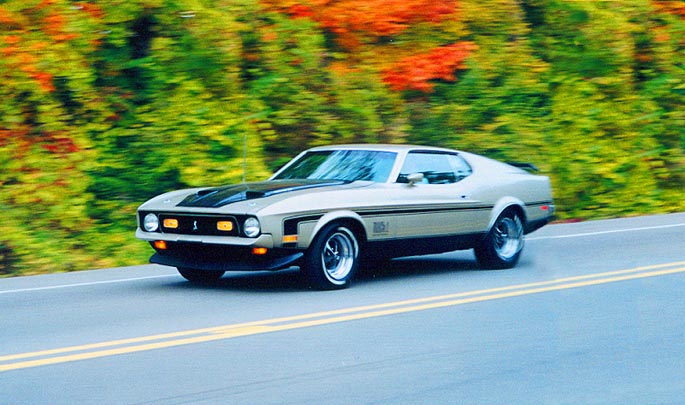
John
Blair's 429 SCJ Mach 1 |
![]()
![]()